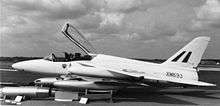Folland Gnat
| Gnat | |
|---|---|
 | |
| Operational Gnat T.1 of the RAF Central Flying School in 1974 | |
| Role | Fighter and trainer |
| Manufacturer | Folland Aircraft |
| Designer | W.E.W. Petter |
| First flight | 18 July 1955 |
| Introduction | 1959, RAF |
| Retired | 1979, UK |
| Primary users | Royal Air Force Indian Air Force Finnish Air Force |
| Number built | 449 (including HAL Ajeet) |
| Developed from | Folland Midge |
| Variants | HAL Ajeet |
The Folland Gnat is a small, swept-wing British subsonic light fighter aircraft and jet trainer developed by Folland Aircraft for the Royal Air Force.
The Gnat was designed by W.E.W. Petter as a development of the private venture Folland Midge. It first flew in 1955. Its design allowed its construction without specialised tools by countries not highly industrialised.[1][2] The Gnat F.1 was exported to Finland, Yugoslavia and India. The Indian Air Force became the largest operator and eventually manufactured the aircraft under licence. India then developed the HAL Ajeet, a modified and improved variant.
Although never used as a fighter by the Royal Air Force (RAF), the Gnat T.1 jet trainer variant was widely used. The Gnat became well known as the aircraft of the RAF's Red Arrows aerobatic team.
Design and development
Origins
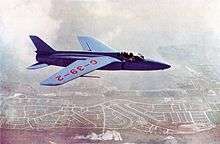
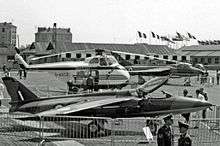
The Gnat was the creation of WEW "Teddy" Petter, a British aircraft designer formerly of Westland Aircraft and English Electric. It was designed to meet the 1952 Operational Requirement OR.303 calling for a lightweight fighter. Petter believed that a small, simple fighter would offer the advantages of low purchase and operational costs. New lightweight turbojet engines that were being developed enabled the concept to take shape.[1] In 1951, using company funds, he began work on his lightweight fighter concept, which was designated the "Fo-141 Gnat".[3] The Gnat was to be powered by a Bristol BE-22 Saturn turbojet with 3,800 lbf (16.9 kN 1,724 kgp) thrust. However, the Saturn was cancelled, and so Petter's unarmed proof-of-concept demonstrator for the Gnat was powered by the less powerful Armstrong Siddeley Viper 101 with 1,640 lbf (7.3 kN / 744 kgp) thrust. The demonstrator was designated Fo-139 "Midge".
The Folland Midge private venture, which however had only a short lifespan, but served as a proof-of-concept design. It failed to interest the RAF as a combat aircraft, but they encouraged the development of a similar aircraft for training purposes.[4] The Midge first flew on 11 August 1954. Despite the low-powered engine, the little jet could break Mach 1 in a dive and was very agile. It was later destroyed in a crash on 20 September 1955, possibly due to human error.[5]
The Gnat, being developed in parallel with the Midge, was an improved version of the original fighter design, differentiated by larger air intakes for the Bristol Orpheus engine (the Midge had an Armstrong Siddeley Viper engine), a slightly larger wing, and provision for a 30 mm ADEN cannon in each intake lip.[4][6]
The first prototype Gnat was built as a private venture project by Folland, but subsequently six further aircraft were ordered by the British Ministry of Supply for evaluation.[4] The Folland prototype, serial number G-39-2, first flew on 18 July 1955 from Boscombe Down.[lower-alpha 1][7]
Although the evaluation by the British brought no orders for the lightweight fighter, orders were placed by Finland and Yugoslavia. India placed a large order which included licence for production by Hindustan Aeronautics Limited. Although the Gnat's development is considered a factor which motivated the Mutual Weapons Development Team to issue the NATO NBMR-1 requirement for a low level strike/attack light fighter, the Gnat itself was not evaluated in the competition, which was won by the Fiat G.91.[8] However, the Gnat was evaluated in 1958 by the Royal Air Force as a replacement for the de Havilland Venom, as well as other light aircraft such as the BAC Jet Provost.[9] The Hawker Hunter was the eventual winner of the fly-off competition.
Gnat Trainer
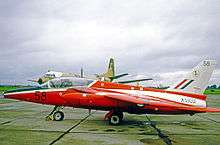
Although RAF interest in the possibilities for the Gnat's use as a fighter waned, the aircraft was modified to meet the 1957 Trainer Specification T.185D, that called for an advanced two-seat trainer that could transition pilots between the current DH Vampire T 11 and operational fighters, such as the English Electric Lightning.[4] Folland proposed the two-seat Fo. 144 Gnat Trainer. It had a new wing with additional fuel capacity, which in turn allowed more room in the fuselage for additional equipment. A more powerful variant of the Orpheus engine was used, the length of the forward end of the fuselage was increased, and the tail surfaces were enlarged. The inboard ailerons of the fighter variant were changed to outboard ailerons and conventional flaps.
An initial contract for 14 pre-production Gnat trainers was issued on 7 January 1958.[10] The prototype Gnat Trainer first flew on 31 August 1959 from Chilbolton airfield,[11] The Ministry did not at first place a production order as they were concerned about the size and ability of the company to take on a large order. Following the take over of Folland by Hawker Siddeley Aviation (becoming the Hamble division) further orders for 30, 20 and 41 trainers were placed between February 1960 and March 1962 with the designation Gnat T Mk. 1.[12] The last Gnat T.1 for the RAF was delivered in May 1965.
Operational history
Finland
The Finnish Air Force received the first of its 13 Gnats (11 fighters and 2 photo-reconnaissance planes) on 30 July 1958. It was soon found to be a problematic aircraft in service and required a lot of ground maintenance. In early 1957 a licence agreement was reached to allow Valmet to build the Gnat at Tampere in Finland,[13] although in the end none was built. On 31 July 1958, the Finnish Air Force Major Lauri Pekuri, a World War II fighter ace, broke the sound barrier for the first time in Finland at Lake Luonetjärvi with a Folland Gnat.[14]
Gnat F.1 proved initially problematic in the Finnish harsh conditions. Finland was the first operational user of Gnat F.1, and the plane had still many issues yet unresolved. All Gnats were grounded for half a year on 26 August 1958 after the destruction of GN-102 due to a technical design error on hydraulic system, and the aircraft soon became the subject of severe criticism. Three other aircraft were also destroyed in other accidents, with two pilots ejecting and one being killed. Once the initial problems were ironed out, the plane proved to be extremely manouevreable and have good performance in the air, but also to be very maintenance intensive. The availability of spare parts was always an issue, and its maintenance a challenge to the conscript mechanics. The Gnats were removed from active service in 1972 when the Häme Wing moved to Rovaniemi, and when the new Saab 35 Drakens were brought into use.[4]
The Finnish Air Force serial codes for Folland Gnat were GN-100..GN-113 and its usual nickname Nutikka ("Stubby"). Several Finnish Gnat F.1s still survive either as museum pieces or memorials. One airframe, GN-113, is in private ownership.
India
The first 13 aircraft for the Indian Air Force (IAF) were assembled at Hamble-le-Rice, they were followed by partly completed aircraft and then sub-assemblies as Hindustan Aircraft slowly took over first assembly, and then production of the aircraft. The first flight of an Indian Air Force Gnat was in the United Kingdom on 11 January 1958, it was delivered to India in the hold of a C-119, and accepted by the Air Force on 30 January 1958. The first Gnat squadron was the No. 23 (Cheetah), which converted from Vampire FB.52 on 18 March 1960 using six Folland-built Gnats. The first aircraft built from Indian-built parts first flew in May 1962. The last Indian-built Gnat F.1 was delivered on 31 January 1974.
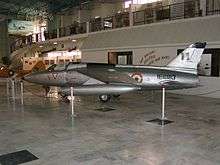
The Gnat is credited by many independent and Indian sources as having shot down seven Pakistani Canadair Sabres[lower-alpha 2] in the 1965 war.[15][16] while two Gnats were downed by PAF fighters. During the initial phase of the 1965 war, an IAF Gnat, piloted by Squadron Leader Brij Pal Singh Sikand, mistakenly landed at an abandoned Pakistani airstrip at Pasrur and was captured by the PAF. Two Lockheed F-104 Starfighters claimed to have forced the Gnat down.[17][18] This Gnat is displayed as a war trophy in the Pakistan Air Force Museum, Karachi. After the ceasefire, one Pakistani Cessna O-1 was shot down on 16 December 1965 by a Gnat.[15]
The Gnats were used again by India in the Indo-Pakistani War of 1971 against Pakistan.[19][20] The most notable action was the Battle of Boyra where the first dogfights over East Pakistan (Bangladesh) took place. The Indian Air Force (IAF) Gnats downed two PAF Canadair Sabres in minutes and badly damaged one. The Pakistan Air Force claims that one Gnat was shot down, which was proved incorrect. Another notable dogfight involving a Gnat was over Srinagar airfield where a lone Indian pilot held out against six Sabres,[21] scoring hits on two of the Sabres in the process,[22][23] before being shot down. Gnat pilot Nirmal Jit Singh Sekhon was posthumously honoured with the Param Vir Chakra (India's highest gallantry award), becoming the only member of the IAF to be given the award.
By the end of 1971, the Gnat proved to be a frustrating opponent for the larger, heavier and older Sabre. The Gnat was referred to as a "Sabre Slayer" by the IAF since most of its combat "kills" during the two wars were against Sabres.[24][25] The Canadair Sabre Mk 6 was widely regarded as the best dogfighter of its era.[26] Tactics called for Gnats taking on the Sabres in the vertical arena, where the Sabres were at a disadvantage. As the Gnat was lightweight and compact in shape, it was hard to see, especially at the low levels where most dogfights took place.[16] Apart from air defence operations, they performed multiple roles in the Bangladesh Liberation War, including anti-shipping operations, ground attack, bomber/transport escort and close air support with devastating effects on the PAF.[19][20]
The IAF was impressed by the Gnat's performance in the two wars, but the aircraft had problems including hydraulics and unreliable control systems. To address these issues, the IAF issued a requirement for an improved "Gnat II" in 1972, at first specifying that the new version was to be optimized as an interceptor, but then expanding the specification to include the ground-attack role. Over 175 of the Hindustan Aeronautics Limited-built licensed version, the Ajeet ("Unconquerable"), were produced in Bangalore. Several Gnats remain in use in private hands. Some IAF Gnats, one of which had participated in the 1971 war in East Pakistan (present day Bangladesh), were presented to the Bangladesh Air Force.[27]
United Kingdom
The first production Gnat T.1s for the Royal Air Force were delivered in February 1962 to the Central Flying School at RAF Little Rissington. The major operator of the type was 4 Flying Training School at RAF Valley, the first aircraft being delivered in November 1962. In 1964 4 FTS formed the Yellowjacks aerobatic team with all-yellow painted Gnats. The team reformed in 1965 as part of the Central Flying School as the Red Arrows which operated the Gnat until 1979 as the RAF aerobatic demonstration team.[4] On 14 May 1965 the last Royal Air Force Gnat T.1 to be built was delivered to the Red Arrows.

Once pilots graduated from basic training on the BAC Jet Provost and gained their wings they were selected for one of three streams: fast jet, multi-engined, or helicopter. Those selected for fast jets were posted to RAF Valley for advanced training on the Gnat T.1, typically 70 hours of flying. Students would then move on to operational training using the Hawker Hunter, followed by a posting to an operational conversion unit for the type of aircraft to be flown.
Following the introduction of the Hawker Siddeley Hawk into the training role as a replacement the Gnats were withdrawn from service.[4] The largest operator 4 FTS retired its last Gnat in November 1978. Most of the retired Gnats were delivered to No. 1 School of Technical Training at RAF Halton and other training establishments to be used as ground training airframes. When the RAF had no need for the Gnats as training airframes they were sold off. Many were bought by private operators and are still flying in 2014.
Yugoslavia
Yugoslavia ordered two Gnat F.1s for evaluation; the first aircraft flew on 7 June 1958 and both were delivered to Yugoslavia by rail. The aircraft were flown by the flight test centre but no further aircraft were ordered. One aircraft was destroyed in a crash in October 1958 while the other is preserved and on display in Serbia.
Variants
- Fo.140 Gnat
- Private-venture prototype fighter, one built.
- Fo.141 Gnat
- Gnat F.1
- Single seat lightweight fighter exported to Finland, India and Yugoslavia, 50 built by Folland at Hamble. This was also built in India under licence as the HAL Gnat.
- Gnat FR.1
- One aircraft for Finland was built with three nose-mounted 70mm Vinten cameras and designated FR.1, it was joined by a Ministry of Supply aircraft purchased by Folland and modified to the same standard. Both aircraft were delivered to Finland on 12 October 1960.
- Fo.142 Gnat / Gnat F.2
- This was to be an improved F.1 using a wing with a 6% thickness to chord ratio and powered by a Bristol Orpheus with simplified reheat (BOr.12SR), developing 8000 lbF (35.6 kN) thrust.[28] A prototype wing was built but not mated to a fuselage or engine. It was anticipated that this would be capable of M 1.5 and have a "marked increase in rate of climb"[29] Development was ended because Bristol declined to back development of the reheat.[30]
- Fo.143 Gnat / Gnat F.4
- Proposed improved F.2 with air intercept radar and ability to carry guided weapons, not built.[31]
- Fo.144 Gnat Trainer / Gnat T.1
- Two-seat advanced trainer aircraft for the Royal Air Force, 105 built by Hawker Siddeley.
- Gnat F.5
- Proposed development from January 1960, with larger wing (and flap) area. It was to be powered by two Rolls-Royce RB153 engines with reheat. The design also considered operation from aircraft carriers.[32]
- Fo.146
- This was a two seat design with variable geometry wings based on a combination of the Gnat Mk5 and the Gnat Trainer. It was to be powered by two Rolls-Royce RB153 engines with reheat and thrust-reversers. it was to be produced as either an advanced trainer with weapons capability or as a fighter. This, and later studies were led by Maurice Brennan.[33]
- HAL Ajeet
- Indian development of the Gnat F.1
- HAL Ajeet Trainer
- Two-seat tandem trainer version for the Indian Air Force. This version was derived from the HAL Ajeet and differed considerably from the Gnat T.1 used by the RAF.
Operators
_K-SIM_01.jpg)
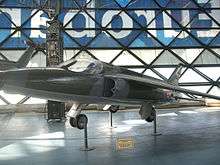
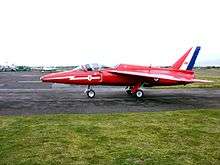
- Indian Air Force
- No.2 Squadron
- No.9 Squadron
- No.15 Squadron
- No.18 Squadron
- No.21 Squadron
- No.22 Squadron
- No.23 Squadron
- No.24 Squadron
- Royal Aircraft Establishment operated one former Royal Air Force Gnat T.1 from Bedford for trials work.
- Royal Air Force
- Central Flying School
- Yellowjacks aerobatic team
- 4 Flying Training School, RAF Valley
- Red Arrows aerobatic team
- Central Flying School
- SFR Yugoslav Air Force two aircraft for evaluation.
Surviving aircraft
Several Gnats survive including some airworthy examples (particularly in the United States and the United Kingdom) and others on public display.
One Gnat is in public display at Bangladesh Airforce Museum, Dhaka
http://www.bafmuseum.mil.bd/portfolio3.html
Specifications (Gnat F.1)
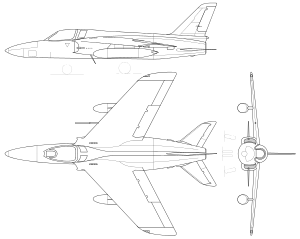
Data from The Great Book of Fighters[34]
General characteristics
- Crew: 1
- Length: 28 ft 8 in (8.74 m)
- Wingspan: 22 ft 1 in (6.73 m)
- Height: 8 ft 1 in (2.46 m)
- Wing area: 136.6 ft² (12.69 m²)
- Airfoil: RAE 101 [35]
- Empty weight: 4,800 lb (2,175 kg)
- Loaded weight: 6,250 lb [36] (2,835 kg)
- Max. takeoff weight: 9,040 lb (4,100 kg)
- Powerplant: 1 × Bristol Siddeley Orpheus 701-01 turbojet, 4,705 lbf (20.9 kN)
Performance
- Maximum speed: 695 mph (mach 0.95) (1,120 km/h) at 20,000 ft (6,100 m)
- Range: 500 mi (800 km)
- Service ceiling: 48,000 ft (14,630 m)
- Rate of climb: 20,000 ft/min (101.6 m/s)
Armament
- 2x 30mm ADEN cannons
- 2x 500 lb (227 kg) bombs or 18x 3 in (76 mm) rockets
Accidents and incidents
- 31 July 1956 the prototype G-39-2 crashed at Stockbridge and was destroyed after structural failure caused by tailplane flutter which breaks away.[lower-alpha 3]
- 15 October 1958 a development F.1 XK767 fatally crashed at Stapleford in Wiltshire following presumed control failure.
- 13 April 1966 RAF Gnat T.1 XP507 of 4FTS flew into the sea on approach to RAF Valley.
- 23 August 1967 RAF Gnat T.1 XP512 abandoned overhead RAF Valley at 3,000 feet (910 m) following seizure of Hobson Unit in tailplane during previous roller landing. Instructor seriously injured; student pilot uninjured. Aircraft subsequently flew for about 5 minutes in large circle before crashing on Rhosneigr beach amongst bathers but inflicting no injuries on the public.
- 26 March 1969 RAF Gnat T.1 XR573 of the CFS crashed into tree during formation display practice.
- 20 January 1971 two RAF Gnat T.1s XR545 and XR986 of CFS collided and both crashed during practice display flying at RAF Kemble.
- 3 September 1975 RAF Gnat T.1 XS103 of the CFS collided with an Italian Air Force Lockheed F-104 Starfighter near Leck, both aircraft landed safely but due to damage the Gnat was written off.
- 30 April 1976 two RAF Gnat T.1s XP536 and XR983 of 4FTS collided and both crashed over North Wales.
- 30 June 1976 RAF Gnat T.1 XM707 of the CFS was abandoned near RAF Kemble following loss of control of tailplane.
- 29 July 2013 Gnat T.1 XS105 (N18GT) Crashed near Georgetown, SC, USA. The aircraft was destroyed.
- 1 August 2015, Gnat T.1 XP504 (though labelled XS111) of a Gnat display team crashed at the 'CarFest North' motoring festival at Oulton Park in Cheshire, during a display at the event; no ground injuries. Pilot Kevin Whyman died in the incident.[37]
Notable appearances in media
The Gnat portrayed the fictional carrier-based "Oscar EW-5894 Fallus Tactical Fighter Bomber" flown by U.S. Navy pilots in the 1991 comedy Hot Shots!.[38]
See also
- Related development
- Aircraft of comparable role, configuration and era
- Related lists
References
The initial version of this article was based on a public domain article from Greg Goebel's Vectorsite.
- Notes
- ↑ It had been moved from the Folland factory at Hamble by road earlier in the day, after a 15-minute flight the Gnat landed at Chilbolton airfield, Hampshire.
- ↑ Licence-built North American F-86 Sabres with Canadian engines.
- ↑ The Folland test pilot, Teddy Tennant, bailed out and descended safely, becoming first person to use the Folland/Saab ejection seat in action.
- Citations
- 1 2 Taylor 1969, p. 365.
- ↑ Willis 2008, p. 40.
- ↑ Flight 20 August 1954, p. 228.
- 1 2 3 4 5 6 7 Frédriksen 2001, p. 133.
- ↑ "The Midge Accident Flight 7 October 1955 p575
- ↑ Willis 2008, p. 43.
- ↑ "'Double First' For Folland Gnat", Times, London, ENG, UK: The Times Digital Archive, p. 8, 19 July 1955 .
- ↑ "Fighter Competition with a Worthwhile Prize". New Scientist, 2(46), 3 October 1957, p. 10. ISSN 0262-4079.
- ↑ "Bright Future for Light Fighters." New Scientist, 4(80), 29 May 1958, p. 56. ISSN 0262-4079.
- ↑ Willis 2008, p. 53.
- ↑ Burnet 1982, p. 62.
- ↑ Burnet 1982, p. 63.
- ↑ "From all Quarters: Finland to build Gnats". Flight. 4 January 1957. pp. 2–3. Retrieved 6 August 2013.
- ↑ "Stingers Of The North: A Visit to the Gnats of the Finnish Air Force". Flight, 26 July 1962.
- 1 2 Rakshak, Bharat. "Indian Air Force Combat Kills, Indo Pakistan War 1965." History. Retrieved 4 November 2010.
- 1 2 Spick 2002, p. 161.
- ↑ Mohan, Jagan P V S; Chopra, Samir. "Chapter 3". The India-Pakistan Air War of 1965. ISBN 81-7304-641-7. Retrieved 9 January 2015..
- ↑ Tufail, Air Commodore M Kaiser, "Run… It's a 104", Defence Day, PK: Jang (5), p. 5.
- 1 2 Pike, John. "Squadron 22 'Swifts'." Global Security. Retrieved 4 November 2010.
- 1 2 "Folland Gnat F1." RAF Museum. Retrieved: 4 November 2010.
- ↑ Mirza. Wg Cdr Salim Baig, PAF. "Air Battles" Bharat Rakshak. December 1971. Retrieved 4 November 2010.
- ↑ "Official Citation of the PVC to NIrmal Jit Singh Sekhon." Bharat Rakshak. Retrieved 4 November 2010.
- ↑ "Param Vir Chakra." Bharat Rakshak. Retrieved 4 November 2010.
- ↑ Bingham 2002.
- ↑ "Three countries, One people by DS Jafa", India Today (book review), 20 September 1999, retrieved 10 March 2009.
- ↑ "Canadair CL-13 Sabre." RCAF. Retrieved 4 November 2010.
- ↑ "Folland/HAL Gnat." Warbirds of India. Retrieved 31 January 2011.
- ↑ "Orpheus a versatile and lightweight turbojet". Flight: 222. 13 February 1959.
- ↑ "Britain's Aircraft Industry 1959". Flight (124). 4 September 1959. Retrieved 20 June 2015.
- ↑ Bingham, Victor (2000). Folland Gnat Sabre Slayer and Red Arrow. J&KH Publishing. p. 105. ISBN 1 900511 78 9.
- ↑ Bingham, Victor (2000). Folland Gnat Sabre Slayer and Red Arrow. J&KH Publishing. p. 106. ISBN 1 900511 78 9.
- ↑ Bingham (2002), p. 106-108.
- ↑ Bingham (2002), p. 114-118,143.
- ↑ Green, William and Gordon Swanborough. The Great Book of Fighters. St. Paul, Minnesota: MBI Publishing, 2001. ISBN 0-7603-1194-3.
- ↑ "Gnat Mk 1". Flight: 800. 22 November 1957.
- ↑ "Folland Aircraft Ltd Gnat Mk 1date=29 August 1958". Flight: 316.
- ↑ Pilot Kevin Whyman killed in CarFest crash in Cheshire BBC, 1 August 2015. Retrieved 2 August 2015.
- ↑ "Hot Shots! (1991)." IMDB. Retrieved 7 August 2011.
- Bibliography
- Bingham, Victor. Folland Gnat: Red Arrow and Sabre Slayer. Hailsham, East Sussex, UK: J&KH Publishing, 2002. ISBN 1-900511-78-9.
- Burnet, Charles. "Folland's (G)Natty Fighters." AIR Enthusiast Twenty-four, April–July 1984. Bromley, Kent, UK: Pilot Press, 1984.
- Chopra, Pushpindar. "Fly with a Sting." Air International, Volume 7, No. 2, August 1974.
- "Folland Midge: The Viper Powered Precursor of the Gnat begins Flying Trials". Flight, 20 August 1954, Vol. 66, No. 2378. pp. 228–229.
- Frédriksen, John C. International Warbirds: An Illustrated Guide to World Military Aircraft, 1914–2000. Santa Barbara, CA: ABC-CLIO, 2001. ISBN 1-57607-364-5.
- Ross, Andrew L. The Political Economy of Defense: Issues and Perspectives. Westport, CT: Greenwood Press, 1991. ISBN 0-313-26462-7.
- Spick, Mike. Illustrated Directory of Fighters. Osceola, WI: Zenith Press, 2002. ISBN 0-7603-1343-1.
- Taylor, John W.R. "Folland Gnat." Combat Aircraft of the World from 1909 to the present. New York: GP Putnam's Sons, 1969. ISBN 0-425-03633-2.
- Willis, David. "The Folland Gnat (Database)." Aeroplane, September 2008.
External links
| Wikimedia Commons has media related to Folland Gnat. |
- "Aspects of the Gnat"
- Folland Gnat Trainer – description in Flight with cutaway
- De Havilland Aviation Ltd operates the only airworthy former Red Arrows Gnat in Europe, XR537 (G-NATY).
- Thunder and Lightnings
- Cockpit restoration of XM692
- The Wolfpack in action
- "The Answer to Europe's Air Defence Problem", a 1954 Flight advertisement for the Folland Gnat
- "Thoughts on the Gnat" – a 1953 Flight article on the Gnat Light Fighter
